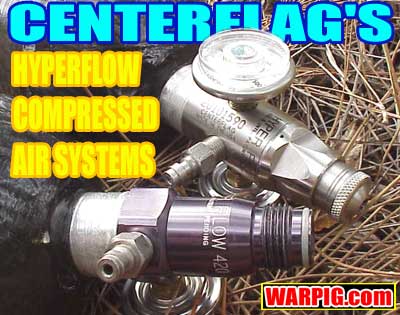
Centerflag Products'
420 and 201 Hyperflow
Compressed Air Systems
by Bill Mills
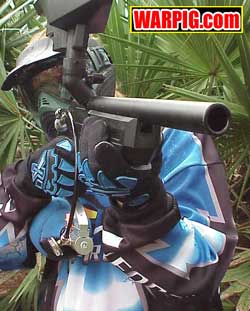 Today,
Centerflag Products is probably best known for their electronic trigger
frames for the Spyder, Piranha, Automag and Autococker paintguns.
Centerflag was alive and well before these products came along though,
producing their Hyperflow line of compressed air regulators. Today,
Centerflag Products is probably best known for their electronic trigger
frames for the Spyder, Piranha, Automag and Autococker paintguns.
Centerflag was alive and well before these products came along though,
producing their Hyperflow line of compressed air regulators.
The 420 and 201 models are good representatives
of their product line. Centerflag has a lot of variety in their regulator
lineup, and sometimes the differences between two regulator models are
only small internal components, or the addition or removal of a particular
feature.
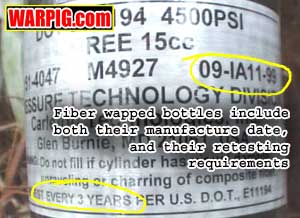 Both
systems reviewed are 4500 psi models (as are most of the Hyperflow regs)
and were mounted on Carleton fiber 68 cubic inch composite tanks, each
rated for 4500 psi use. As with all compressed air tanks, the manufacturing
date must be checked prior to filling. On the label, "09-IA11-99"
indicates the tanks were made in September of 1999, and the bottom of the
label indicates the tank must be hydrotested every three years, so the
tanks may be used until August 30, 2002, when they will need to be retested.
Some newer tanks can go 5 years between tests, and this will be indicated
on their label. Both
systems reviewed are 4500 psi models (as are most of the Hyperflow regs)
and were mounted on Carleton fiber 68 cubic inch composite tanks, each
rated for 4500 psi use. As with all compressed air tanks, the manufacturing
date must be checked prior to filling. On the label, "09-IA11-99"
indicates the tanks were made in September of 1999, and the bottom of the
label indicates the tank must be hydrotested every three years, so the
tanks may be used until August 30, 2002, when they will need to be retested.
Some newer tanks can go 5 years between tests, and this will be indicated
on their label.
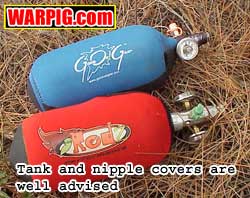 While
many fields still do not offer 4,500 psi air fills, the ability to get
the added shots per fill that the higher pressure offers makes 4,500 psi
systems quite attractive. When only 3,000 psi fills are available,
they will still function properly, with a penalty in the number of shots
available. While
many fields still do not offer 4,500 psi air fills, the ability to get
the added shots per fill that the higher pressure offers makes 4,500 psi
systems quite attractive. When only 3,000 psi fills are available,
they will still function properly, with a penalty in the number of shots
available.
The 420 is a fixed output regulator,
while the 201 is an adjustable model. Both have key features found
in the entire Hyperflow line which set them apart from other regulators
used in paintball. The Hyperflows have separate fill and exhaust
gas paths. Some regulator designs route the gas past the regulator
pin during filling. According to Centerflag's Dennis Ashley, this
can cause problems both in high temperature gas affecting the regulator
pin spring and the pressure of the gas blowing the regulator pin off-center.
The Hyperflow design avoids this entirely by using a gas path from the
fill nipple to the tank that is completely separated from the path from
the tank to the regulator output. Additionally they feature a filter
at the base of their neck. While there is no excuse for not keeping
a regulator fill nipple protected from dust and debris with a nipple cap,
some dust and debris will eventually find its way into the tank.
The internal filter adds an extra layer of protection for the regulator.
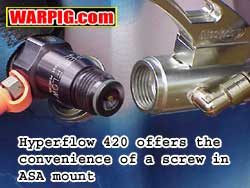 The
Hyperflow 420 is an ASA screw-in model. It is preset to output 750
psi, and makes switching from CO2 to compressed air
literally as easy as unscrewing the CO2 tank, and
screwing in the Hyperflow. Many players shy away from preset air
systems, opting for the higher end adjustables. The preset actually
has some major advantages. At 750 psi, it can adequately drive a
paintgun that is set up for CO2 (a blowback semi,
like a Spyder or Piranha). Higher end paintguns are typically equipped
with an adjustable regulator, this gives the user the ability to operate
at lower pressures, and 750 psi is a good input pressure to feed a second
regulator. The
Hyperflow 420 is an ASA screw-in model. It is preset to output 750
psi, and makes switching from CO2 to compressed air
literally as easy as unscrewing the CO2 tank, and
screwing in the Hyperflow. Many players shy away from preset air
systems, opting for the higher end adjustables. The preset actually
has some major advantages. At 750 psi, it can adequately drive a
paintgun that is set up for CO2 (a blowback semi,
like a Spyder or Piranha). Higher end paintguns are typically equipped
with an adjustable regulator, this gives the user the ability to operate
at lower pressures, and 750 psi is a good input pressure to feed a second
regulator.
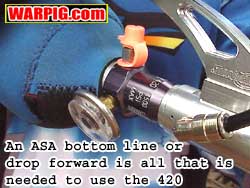 ASA
connections are a standard in paintball, and there are a wide variety of
bottom-lines, remotes, and other gas mounts which can be used with the
420. ASA
connections are a standard in paintball, and there are a wide variety of
bottom-lines, remotes, and other gas mounts which can be used with the
420.
With no adjustments to be set wrong,
and the ease of simply unscrewing the tank to fill it separate from the
paintgun, or pack for travel, screw in presets like the 420 can be a great
way to go. Three openings, placed radially around the neck allow
for a tank pressure gauge, fill nipple, and the burst disk which protects
the tank and regulator from overfilling. A brass pin valve opens
when the 420 is screwed into an ASA.
So why not go with the 420? What
else does the 201 offer?
The 420 is not built to be serviceable.
Basically if anything goes wrong, Centerflag's answer is to send it back
in for service. The 201, and other adjustable Hyperflow regulators
are designed not only for reliability, but also for easy field service
which can be important in a tournament environment.
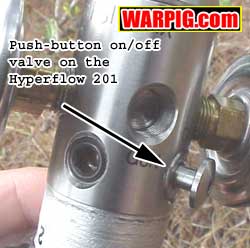 Unlike
the lower cost model 200, the 201 features an on/off valve. Switching
off the gas supply not only allows for the gauges and hoses to be changed
with air in the tank, but also for all of the main regulator components
to be serviced as well. For an adjustable regulator, the on/off is
a nice feature as it means the regulator doesn't need to be readjusted
each time it is turned on or off. Unlike
the lower cost model 200, the 201 features an on/off valve. Switching
off the gas supply not only allows for the gauges and hoses to be changed
with air in the tank, but also for all of the main regulator components
to be serviced as well. For an adjustable regulator, the on/off is
a nice feature as it means the regulator doesn't need to be readjusted
each time it is turned on or off.
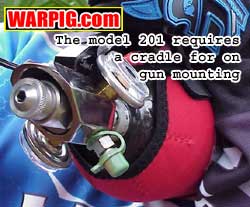 The
201's cylindrical stainless steel construction gives it strength and radially
symmetrical design, but is lacking a component found on many adjustable
regulators - a dovetail slot for mounting on a grip frame or bottom line.
Instead the 201 requires a cradle. The mounting cradle fits like
a sleeve over the regulator body, and has a dovetail slot on top to allow
use with a variety of drop forwards. Laser engraving clearly labels
all of the ports on the 201, like all of Centerflag's regulators.
This provides important protection from accidentally mis-installing hoses
or gauges. The
201's cylindrical stainless steel construction gives it strength and radially
symmetrical design, but is lacking a component found on many adjustable
regulators - a dovetail slot for mounting on a grip frame or bottom line.
Instead the 201 requires a cradle. The mounting cradle fits like
a sleeve over the regulator body, and has a dovetail slot on top to allow
use with a variety of drop forwards. Laser engraving clearly labels
all of the ports on the 201, like all of Centerflag's regulators.
This provides important protection from accidentally mis-installing hoses
or gauges.
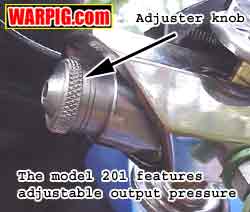 At
the base of the 201 is it's on/off valve. The overfill burst disk
is on the same level as the on/off. Further up on the regulator body
are the tank gauge, low pressure output, low pressure gauge, and fill nipple.
At the end of the regulator is the adjuster. It's knurled edges make
hand adjustment possible, but tuning is most easily done with a 3/16" allen
wrench. At
the base of the 201 is it's on/off valve. The overfill burst disk
is on the same level as the on/off. Further up on the regulator body
are the tank gauge, low pressure output, low pressure gauge, and fill nipple.
At the end of the regulator is the adjuster. It's knurled edges make
hand adjustment possible, but tuning is most easily done with a 3/16" allen
wrench.
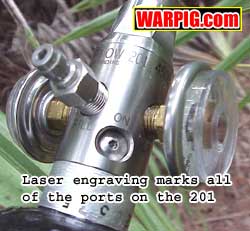 Laser
engraving on the regulator body shows which side to press to turn it on
or off. In the off position, both sides of the valve are nearly flush
to the body. In the on position, the "off" side of the button extends
roughly 1/4 inch from the body. The valve takes a fair amount of
force to operate, and makes a surprisingly loud popping sound when turning
it off. According to Centerflag, keeping the on/off lightly lubricated
is important to keeping it usable. Laser
engraving on the regulator body shows which side to press to turn it on
or off. In the off position, both sides of the valve are nearly flush
to the body. In the on position, the "off" side of the button extends
roughly 1/4 inch from the body. The valve takes a fair amount of
force to operate, and makes a surprisingly loud popping sound when turning
it off. According to Centerflag, keeping the on/off lightly lubricated
is important to keeping it usable.
 NOTE:
Disassembly/Assembly information is provided to give the reader a better
understanding of the function of this regulator. Air system service
should only be performed by a qualified airsmith. NOTE:
Disassembly/Assembly information is provided to give the reader a better
understanding of the function of this regulator. Air system service
should only be performed by a qualified airsmith.
The on/off is designed with easy maintenance
in mind. With the tank completely empty, a pair of 3/32 inch allen
wrenches can be used to disassemble it - one on either side of the valve
core can be used to unscrew its ends. With the button removed from
the "on" end of the core, the on/off valve core can be slid out of the
"off" side. Order of placement is important as the valve will not
function properly if the valve core is reinserted from the wrong side.
 With
the valve core removed, a 3/16" allen wrench can be used to remove the
hollow nut which holds all of the on/off seals in place. An o-ring
pick can be used to remove each of the three white o-rings and two brass
spacers which seal the valve. A fourth o-ring, of black material
sits in an internal groove inside the regulator body. This o-ring
is quite tricky to remove, and will likely be damaged in the process of
removal. An on/off leak when the valve is off, is most likely due
to damage on this o-ring. An on/off leak when the valve is on is
usually from damage to one of the white o-rings. Reassembly is done
in the reverse order of assembly. With
the valve core removed, a 3/16" allen wrench can be used to remove the
hollow nut which holds all of the on/off seals in place. An o-ring
pick can be used to remove each of the three white o-rings and two brass
spacers which seal the valve. A fourth o-ring, of black material
sits in an internal groove inside the regulator body. This o-ring
is quite tricky to remove, and will likely be damaged in the process of
removal. An on/off leak when the valve is off, is most likely due
to damage on this o-ring. An on/off leak when the valve is on is
usually from damage to one of the white o-rings. Reassembly is done
in the reverse order of assembly.
It is important to note that the on/off
cuts off not only the regulator, but the tank gauge as well. If the
air system is turned off, the tank gauge will read 0 psi, despite the fact
that the tank may be full. This means that in order to tell how full
the tank is, the 201 must be hooked up to a paintgun and then turned on.
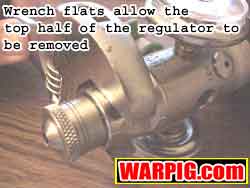 Adjustment
of the 201 is very simple. The adjuster knob is turned in for higher
output pressure, out for lower. The low pressure gauge indicates
the output pressure within the regulator's range (0-1,000 psi) and a bit
beyond (up to 1,500 psi). It is important to remember when adjusting
regulator output pressure that the pressure between the regulator and the
paintgun will not drop as the regulator setting is backed off. Instead,
after each downward adjustment a couple of shots must be fired to relieve
the stored pressure. Adjustment
of the 201 is very simple. The adjuster knob is turned in for higher
output pressure, out for lower. The low pressure gauge indicates
the output pressure within the regulator's range (0-1,000 psi) and a bit
beyond (up to 1,500 psi). It is important to remember when adjusting
regulator output pressure that the pressure between the regulator and the
paintgun will not drop as the regulator setting is backed off. Instead,
after each downward adjustment a couple of shots must be fired to relieve
the stored pressure.
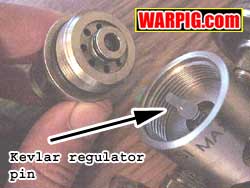 Maintenance
of the upper end of the regulator is surprisingly easy. While the
on/off depressurizes the top end for disassembly, it is ideal to completely
depressurize the entire tank before taking any of the regulator components
apart. Wrench flats in the sides of the regulator top half make its
removal simple. Unscrewing the top half of the regulator provides
direct access to it's two o-rings, and the Kevlar(TM)
regulator pin. The Kevlar(TM) pin functions
as most regulator pins do, but also acts as it's own seal against the regulator
body. It's short length (compared to the regulator pin on other designs)
and self centering shape means that bent regulator pins are not a problem
in the Centerflag design. Maintenance
of the upper end of the regulator is surprisingly easy. While the
on/off depressurizes the top end for disassembly, it is ideal to completely
depressurize the entire tank before taking any of the regulator components
apart. Wrench flats in the sides of the regulator top half make its
removal simple. Unscrewing the top half of the regulator provides
direct access to it's two o-rings, and the Kevlar(TM)
regulator pin. The Kevlar(TM) pin functions
as most regulator pins do, but also acts as it's own seal against the regulator
body. It's short length (compared to the regulator pin on other designs)
and self centering shape means that bent regulator pins are not a problem
in the Centerflag design.
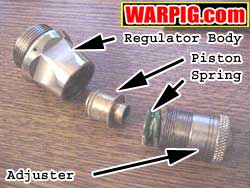 Fully
unscrewing the adjuster knob reveals the regulator's main spring and brass
piston. Leaks through the adjuster knob are typically caused by damage
to the piston's o-ring or to it's internal relief valve. Since the
relief valve vents excess pressure between the regulator and the paintgun,
the output pressure gauge can further diagnose air venting from the relief
valve. If the pressure is normal, it would indicate a damaged relief
valve. Unusually high output pressure indicates a dirty or damaged
regulator pin. Fully
unscrewing the adjuster knob reveals the regulator's main spring and brass
piston. Leaks through the adjuster knob are typically caused by damage
to the piston's o-ring or to it's internal relief valve. Since the
relief valve vents excess pressure between the regulator and the paintgun,
the output pressure gauge can further diagnose air venting from the relief
valve. If the pressure is normal, it would indicate a damaged relief
valve. Unusually high output pressure indicates a dirty or damaged
regulator pin.
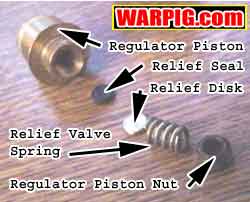 If
a bad relief valve seal is indicated, 1/8" allen key is needed to remove
the hollow nut from the top of the regulator piston. Inside is a
spring, metal disk, and black poly seal disk. Upon reassembly, the
small dimple in the metal disk should be facing the spring. If
a bad relief valve seal is indicated, 1/8" allen key is needed to remove
the hollow nut from the top of the regulator piston. Inside is a
spring, metal disk, and black poly seal disk. Upon reassembly, the
small dimple in the metal disk should be facing the spring.
Construction aside, performance in the
field is the most important aspect of any paintball product. Both
regulators were field tested on an E-Matrix, E-Mag, Minimag and Tippmann
Model 98 at a variety of fields including Spacecoast
Paintball, Command
Post, and Paintball
Long Island.
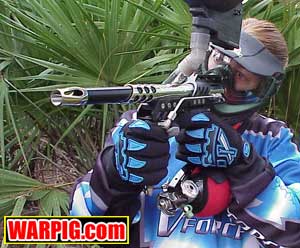 Both
systems performed without problem. On the Model 98, the adjustability
of the Hyperflow 201 meant that it could be dialed in to provide a minimum
of gas pressure needed for reliable recocking, in order to achieve the
best gas efficiency. For the other paintguns, the adjustability was
not as important a factor, as they each had their own second stage regulators
(the 'mags in the AIR valve, the E-Matrix in the vertical regulator).
Both systems performed with solid reliability, and without shoot-down problems.
The 420 proved especially convenient for travel as teardown while packing
was as easy as unscrewing it from the ASA. Both
systems performed without problem. On the Model 98, the adjustability
of the Hyperflow 201 meant that it could be dialed in to provide a minimum
of gas pressure needed for reliable recocking, in order to achieve the
best gas efficiency. For the other paintguns, the adjustability was
not as important a factor, as they each had their own second stage regulators
(the 'mags in the AIR valve, the E-Matrix in the vertical regulator).
Both systems performed with solid reliability, and without shoot-down problems.
The 420 proved especially convenient for travel as teardown while packing
was as easy as unscrewing it from the ASA.
The author would like
to thank Dennis, Will, Josh, and other members of Centerflag's support
staff for technical training and support during the research for this review.
Kevlar is a registered
trademark of the DuPont corporation who's lawyers send threatening letters
to us if we don't remind you of their trademarks.
|





